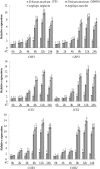Identification of genes from the ICE-CBF-COR pathway under cold stress in Aegilops- Triticum composite group and the evolution analysis with those from Triticeae
- PMID: 29515316
- PMCID: PMC5834981
- DOI: 10.1007/s12298-017-0495-y
Identification of genes from the ICE-CBF-COR pathway under cold stress in Aegilops- Triticum composite group and the evolution analysis with those from Triticeae
Abstract
Adverse environmental conditions limit various aspects of plant growth, productivity, and ecological distribution. To get more insights into the signaling pathways under low temperature, we identified 10 C-repeat binding factors (CBFs), 9 inducer of CBF expression (ICEs) and 10 cold-responsive (CORs) genes from Aegilops-Triticum composite group under cold stress. Conserved amino acids analysis revealed that all CBF, ICE, COR contained specific and typical functional domains. Phylogenetic analysis of CBF proteins from Triticeae showed that these CBF homologs were divided into 11 groups. CBFs from Triticum were found in every group, which shows that these CBFs generated prior to the divergence of the subfamilies of Triticeae. The evolutionary relationship among the ICE and COR proteins in Poaceae were divided into four groups with high multispecies specificity, respectively. Moreover, expression analysis revealed that mRNA accumulation was altered by cold treatment and the genes of three types involved in the ICE-CBF-COR signaling pathway were induced by cold stress. Together, the results make CBF, ICE, COR genes family in Triticeae more abundant, and provide a starting point for future studies on transcriptional regulatory network for improvement of chilling tolerance in crop.
Keywords: CBF; COR; Cold stress; ICE; Triticeae.
Figures





Similar articles
-
Characterization and expression profiling of the ICE-CBF-COR genes in wheat.PeerJ. 2019 Nov 29;7:e8190. doi: 10.7717/peerj.8190. eCollection 2019. PeerJ. 2019. PMID: 31803544 Free PMC article.
-
The Triticeae CBF Gene Cluster-To Frost Resistance and Beyond.Cells. 2023 Nov 11;12(22):2606. doi: 10.3390/cells12222606. Cells. 2023. PMID: 37998341 Free PMC article. Review.
-
Physiological and Molecular Mechanism Involved in Cold Stress Tolerance in Plants.Plants (Basel). 2020 Apr 28;9(5):560. doi: 10.3390/plants9050560. Plants (Basel). 2020. PMID: 32353940 Free PMC article. Review.
-
Structural, functional, and phylogenetic characterization of a large CBF gene family in barley.Plant Mol Biol. 2005 Nov;59(4):533-51. doi: 10.1007/s11103-005-2498-2. Plant Mol Biol. 2005. PMID: 16244905
-
CBF-dependent signaling pathway: a key responder to low temperature stress in plants.Crit Rev Biotechnol. 2011 Jun;31(2):186-92. doi: 10.3109/07388551.2010.505910. Epub 2010 Oct 4. Crit Rev Biotechnol. 2011. PMID: 20919819 Review.
Cited by
-
Overexpression of SiICE2 gene reduces plant height and increases yield in cotton (Gossypium hirsutum).BMC Plant Biol. 2025 Jun 2;25(1):743. doi: 10.1186/s12870-025-06777-3. BMC Plant Biol. 2025. PMID: 40457179 Free PMC article.
-
Characterization and expression profiling of the ICE-CBF-COR genes in wheat.PeerJ. 2019 Nov 29;7:e8190. doi: 10.7717/peerj.8190. eCollection 2019. PeerJ. 2019. PMID: 31803544 Free PMC article.
-
The Triticeae CBF Gene Cluster-To Frost Resistance and Beyond.Cells. 2023 Nov 11;12(22):2606. doi: 10.3390/cells12222606. Cells. 2023. PMID: 37998341 Free PMC article. Review.
-
Unveiling transcriptional regulation underpinning chilling and frost stress response in Trans-Himalayan Hippophae tibetana L.Plant Mol Biol. 2025 Jul 31;115(4):96. doi: 10.1007/s11103-025-01619-0. Plant Mol Biol. 2025. PMID: 40745105
-
Isolation and characterization of wheat ice recrystallisation inhibition gene promoter involved in low temperature and methyl jasmonate responses.Physiol Mol Biol Plants. 2022 Dec;28(11-12):1969-1979. doi: 10.1007/s12298-022-01257-6. Epub 2022 Dec 6. Physiol Mol Biol Plants. 2022. PMID: 36573144 Free PMC article.
References
LinkOut - more resources
Full Text Sources
Other Literature Sources
